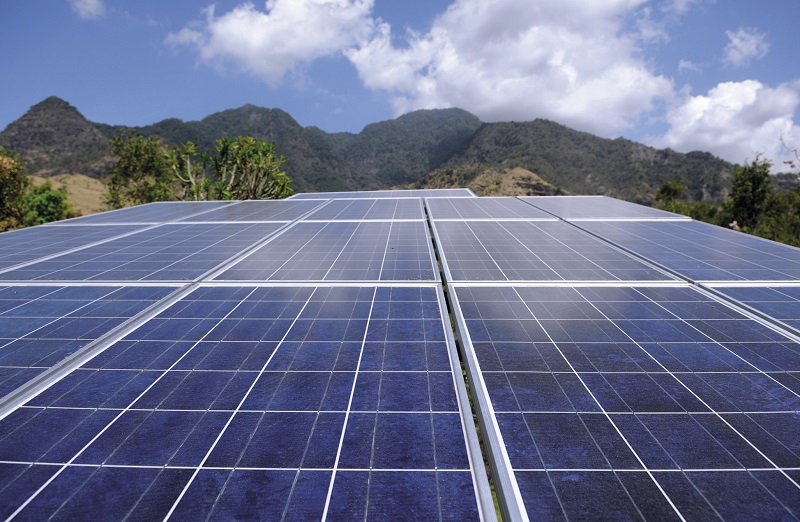Akuo Energy, an independent renewable power producer, and Perusahaan Listrik Negara (PLN), Indonesia’s state-owned vertical integrated energy utility have signed a Letter of Intent to set up a power purchase agreement (PPA) for a 50 MW solar PV project.
Upon completion, the so-called Melaya plant will be located in the northwest of the island of Bali.
The project will cover an area of 55 hectares of uncultivated farmland secured from the Balinese administration. Construction is expected to start in the second half of 2018, while it is slated to come online in 2019.
“General Electric is the project’s preferred technology supplier,” said Akuo Energy in a statement.
Eric Scotto, chairman of Akuo Energy, commented that this major deal leads “the way for the development of utility-scale solar PV energy in Bali, and already makes Melaya the largest-ever solar project developed on the island.”
Earlier this year, the French firm, which established a subsidiary in Bali in 2012, and PLN, also signed a memorandum of understanding (MoU) concerning the feasibility study of 500 MW of hybrid energy systems, comprising solar PV, wind, energy storage and genset.
Of this capacity, Akuo Energy told pv magazine, about 250 MW will comprise solar PV installations developed on small to medium Indonesian islands.
Akuo Energy is also currently also developing a leading community-owned 1.2 MW off-grid solar PV array. As previously reported, the project offers a model for Indonesia’s archipelago, which consists of 17508 islands.
The dispersed geography of the country makes it a challenge to establish on-grid power to its population, of which around 30% do not have access to electricity.
Why Bali?
The Melaya project indicates that Indonesia’s new law on renewable electricity might have very well deliver on the government’s stated goal of increasing renewable development. In January, Indonesia’s Ministry of Energy and Mineral Resources (MEMR) issued the Minister Decree (MD) No. 12/2017 on the utilization of renewable resources for electricity, altering the calculation method for feed-in tariffs (FITs) for renewable power projects. According to the MD No. 12/2017, FITs for renewable power projects will no longer be set by the government, but rather will be the result of negotiation between PLN and independent power producers (IPPs).
The second most important element of the new law is that it provides a FIT cap based on the electricity generation costs of the region where the renewable power project will be developed.
This is the cost state-owned utility PLN needs to cover for generating each kWh in the region’s electricity system and sub-systems, including investment, fuel and O&M expenses. Costs for transmission and electricity distribution are excluded. When a region has electricity generation costs above the national average, the FIT will be capped at 85%. If a region has an electricity generation cost lower than the national average, then the renewable energy project will receive a FIT equal to the regional cost.
Many analysts have argued that the rationale behind the new law is to convince the PLN to sign more PPAs with independent power investors. Under the previous program, where tariff prices were higher and fixed, the PLN was unwilling to sign renewable power contracts. However, the new law makes some regions more attractive to investment than others.
One example is the case of Lampung and Bali. According to the ministry’s national electricity generation cost estimates for the year 2016, the national average cost for the generation of electricity was US$7.39 cents per kWh. Similarly, Lampung’s electricity generation cost in 2016 was US$7.77 cents per kWh, and Bali’s was US$6.62 cents per kWh.
Based on the new law, a PV project in Lampung will receive US$6.60 cents per kWh, which corresponds to 85% of the regional costs. On the contrary, Bali’s regional electricity generation cost is less than the national average, therefore a potential PV project will have to receive a FIT equal to the regional average.
This leads to a PV project in Lampung receiving less than a PV project in Bali, even though the Lampung electricity generation cost is actually 17% higher.
Edited by Jonathan Gifford
This content is protected by copyright and may not be reused. If you want to cooperate with us and would like to reuse some of our content, please contact: editors@pv-magazine.com.








By submitting this form you agree to pv magazine using your data for the purposes of publishing your comment.
Your personal data will only be disclosed or otherwise transmitted to third parties for the purposes of spam filtering or if this is necessary for technical maintenance of the website. Any other transfer to third parties will not take place unless this is justified on the basis of applicable data protection regulations or if pv magazine is legally obliged to do so.
You may revoke this consent at any time with effect for the future, in which case your personal data will be deleted immediately. Otherwise, your data will be deleted if pv magazine has processed your request or the purpose of data storage is fulfilled.
Further information on data privacy can be found in our Data Protection Policy.